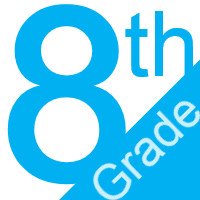8th Grade English
 Standards Glossaries
Standards Glossaries
| K Grade English | 1st Grade English | 2nd Grade English |
 Standards Glossaries
Standards Glossaries
| 3rd Grade English | 4th Grade English | 5th Grade English |
 Standards Glossaries
Standards Glossaries
| 6th Grade English | 7th Grade English | 8th Grade English |
 Standards Glossaries
Standards Glossaries
| 9th Grade English | 10th Grade English | 11th Grade English | 12th Grade English |
 Standards Glossaries
Standards Glossaries
| HS Journalism | HS Speech |
| All categories |
(W) WRITING |
|---|
ELA-08.W.07
Student Learning Targets for 8th ELA:Knowledge Targets
Reasoning Targets
Skills (Performance) Targets
Product Targets
Proficiency Scale for ELA 8:
ResourcesWebsites Vocabulary Student Learning Targets for 8th Communications:Knowledge Targets
Reasoning Targets
Skills (Performance) Targets
Proficiency Scale for ELA 8:Click HERE to view the proficiency scale. | ||||||||||||||||||||||||||||||||||||||||
ELA-08.W.08
Student Learning Targets for 8th ELA:Knowledge Targets
Reasoning Targets
Skills (Performance) Targets
Product Targets
Proficiency Scale for 8th ELA
ResourcesWebsites Vocabulary Student Learning Targets for 8th Communications:Knowledge Targets
Skills (Performance) Targets
Product Targets
Proficiency Scale for 8th Communications:Click HERE to view proficiency scale. | ||||||||||||||||||||||||||||||||||||||||||||
ELA-08.W.09
Student Learning Targets:Knowledge Targets
Reasoning Targets
Skills (Performance) Targets
| ||||||||||||||||||||||||||||||||||||||||||||
| Score | Description | Sample Activity |
|
| 4.0 | In addition to Score 3.0, the student demonstrates in-depth inferences and applications regarding more complex material that go beyond end of instruction expectations. | - | |
| 3.5 | In addition to Score 3.0 performance, the student demonstrates in-depth inferences and applications regarding the more complex content with partial success. | ||
| 3.0 | “The Standard.” The student demonstrates no major errors or omissions regarding any of the information and processes that were end of instruction expectations. | - | |
| 2.5 | The student demonstrates no major errors or omissions regarding the simpler details and processes (Score 2.0 content) and partial knowledge of the more complex ideas and processes (Score 3.0 content). | ||
| 2.0 | The student demonstrates no major errors or omissions regarding the simpler details and processes but exhibits major errors or omissions regarding the more complex ideas and processes (Score 3.0 content). | - | |
| 1.5 | The student demonstrates partial knowledge of the simpler details and processes (Score 2.0 content) but exhibits major errors or omissions regarding the more complex ideas and procedures (Score 3.0 content). | ||
| 1.0 | With help, the student demonstrates a partial understanding of some of the simpler details and processes (Score 2.0 content) and some of the more complex ideas and processes (Score 3.0 content). | - | |
| 0.5 | With help, the student demonstrates a partial understanding of some of the simpler details and processes (Score 2.0 content) but not the more complex ideas and processes (Score 3.0 content). | ||
| 0.0 | Even with help, the student demonstrates no understanding or skill. | - | |
Resources
Websites
Vocabulary
ELA-08.W.10
Student Learning Targets:Knowledge Targets
Reasoning Targets
Skills (Performance) Targets
| ||||||||||||||||||||||||||||||||||||||||||||
| Score | Description | Sample Activity |
|
| 4.0 | In addition to Score 3.0, the student demonstrates in-depth inferences and applications regarding more complex material that go beyond end of instruction expectations. | - | |
| 3.5 | In addition to Score 3.0 performance, the student demonstrates in-depth inferences and applications regarding the more complex content with partial success. | ||
| 3.0 | “The Standard.” The student demonstrates no major errors or omissions regarding any of the information and processes that were end of instruction expectations. | - | |
| 2.5 | The student demonstrates no major errors or omissions regarding the simpler details and processes (Score 2.0 content) and partial knowledge of the more complex ideas and processes (Score 3.0 content). | ||
| 2.0 | The student demonstrates no major errors or omissions regarding the simpler details and processes but exhibits major errors or omissions regarding the more complex ideas and processes (Score 3.0 content). | - | |
| 1.5 | The student demonstrates partial knowledge of the simpler details and processes (Score 2.0 content) but exhibits major errors or omissions regarding the more complex ideas and procedures (Score 3.0 content). | ||
| 1.0 | With help, the student demonstrates a partial understanding of some of the simpler details and processes (Score 2.0 content) and some of the more complex ideas and processes (Score 3.0 content). | - | |
| 0.5 | With help, the student demonstrates a partial understanding of some of the simpler details and processes (Score 2.0 content) but not the more complex ideas and processes (Score 3.0 content). | ||
| 0.0 | Even with help, the student demonstrates no understanding or skill. | - | |
Resources
Websites
Vocabulary
PRIORITIZED STANDARDS |
|---|
ELA-08.L
Narrative for (L) LanguageAs they move through formal schooling, students must continually learn how to gain control over the many conventions of Standard English grammar, usage, and mechanics. They must also learn to apply these language skills to their speaking and writing opportunities in order to help them convey meaning effectively and powerfully. Language standards include the rules of standard written and spoken English as well as the use of language as a craft with many choices. While the sub-standards under the language strand are grade-level specific, it is important to realize that many sub-standards require continued attention, grades 3-12; because of this, students will continue to see an emphasis on language skills that were previously taught. In order to see a clear picture of the progression of language standards, open the attached image above; there you will see that students never stop learning about the enduring standards of our language. English grammar, conventions, knowledge of language and vocabulary extend across reading, writing, speaking and listening and, in fact, are inseparable from these contexts. Calculation Method for StrandsStrands are larger groups of related standards. The Strand Grade is a calculation of all the related standards. Click on the standard name below each strand to access the learning targets and proficiency scales for each strand's related standards. | |
ELA-08.L.01
Student Learning Targets for Grade 8 ELA:Knowledge Targets
Reasoning Targets
Skills (Performance) Targets
Product Targets
Proficiency Scale for Grade 8 ELA:
ResourcesWebsites* http://www.wordgames.com/grammar-ninja.html * http://www.redkid.net/madlibs/
Vocabulary
| ||||||||||||||||||||||||||||||||||||||||
ELA-08.L.02
Student Learning Targets for Grade 8 ELA:Knowledge Targets
Reasoning Targets
Skills (Performance) Targets
Product Targets
Proficiency Scale
ResourcesWebsites https://owl.english.purdue.edu/owl/section/1/6/ Vocabulary phrase gerund infinitive participle appositive clause simple compound complex compound-complex | ||||||||||||||||||||||||||||||||||||||||
ELA-08.L.06
Student Learning Targets for Grade 8 ELA:Knowledge Targets
Reasoning Targets
Skills (Performance) Targets
Product Targets
Proficiency Scale
ResourcesWebsites Vocabulary | ||||||||||||||||||||||||||||||||||||||||
ELA-08.RI
Narrative for (RI) Reading InformationIn grade 8, the North Dakota State Standards call for students to proficiently read grade-appropriate complex informational texts while further developing the ability to cite textual evidence to support their conclusions regarding key ideas and claims. While learning about an author’s point of view, students also examine how authors use reasons to make their points and support arguments with evidence, separating unsupported assertions from those backed by evidence. Students also look at how structure and content contribute to the development of ideas. Reading informative texts has not lessened the focus on reading literature in the English classroom; instead, this reading strand is to be viewed as a shared responsibility with other content areas such as science and social studies. Focusing on how authors make their points and support their arguments with evidence and reasoning helps eighth grade students sharpen their ability to write and speak with more clarity and coherence in all content arenas. Calculation Method for StrandsStrands are larger groups of related standards. The Strand Grade is a calculation of all the related standards. Click on the standard name below each strand to access the learning targets and proficiency scales for each strand's related standards. | |
ELA-08.RI.01
Student Learning Targets for 8th Grade ELA:Knowledge Targets
Reasoning Targets
Skills (Performance) Targets
| ||||||||||||||||||||||||||||||||||||||||
| Score | RI.8.1 Cite the textual evidence that most strongly supports an analysis of what the text says explicitly as well as inferences drawn from the text. | Sample Activity |
|
| 4.0 | In addition to Score 3.0, the student demonstrates in-depth inferences and applications regarding more complex material that go beyond end of instruction expectations. | - | |
| 3.5 | In addition to Score 3.0 performance, the student demonstrates in-depth inferences and applications regarding the more complex content with partial success. | ||
| 3.0 |
“The Standard.” The student demonstrates no major errors or omissions regarding any of the information and processes that were end of instruction expectations. The student:
|
- | |
| 2.5 | The student demonstrates no major errors or omissions regarding the simpler details and processes (Score 2.0 content) and partial knowledge of the more complex ideas and processes (Score 3.0 content). | ||
| 2.0 |
The student demonstrates no major errors or omissions regarding the simpler details and processes but exhibits major errors or omissions regarding the more complex ideas and processes (Score 3.0 content). The student:
|
- | |
| 1.5 | The student demonstrates partial knowledge of the simpler details and processes (Score 2.0 content) but exhibits major errors or omissions regarding the more complex ideas and procedures (Score 3.0 content). | ||
| 1.0 | With help, the student demonstrates a partial understanding of some of the simpler details and processes (Score 2.0 content) and some of the more complex ideas and processes (Score 3.0 content). | - | |
| 0.5 | With help, the student demonstrates a partial understanding of some of the simpler details and processes (Score 2.0 content) but not the more complex ideas and processes (Score 3.0 content). | ||
To view the middle school Read Right Rubric click here.
Resources
Websites
Vocabulary
ELA-08.RI.01.a
ELA-08.RI.01 Read closely to comprehend Informational/Nonfiction text.
Proficiency ScaleThe student can ...1 Beginning... with help, demonstrates a partial understanding of some of the simpler details and processes (Score 2.0 content) and some of the more complex ideas and processes (Score 3.0 content).Start 2 Developing... demonstrates no major errors or omissions regarding the simpler details and processes but exhibits major errors or omissions regarding the more complex ideas and processes (Score 3.0 content).Simple 3 Proficient“The Standard.”... demonstrates no major errors or omissions regarding any of the information and processes that were end of instruction expectations. Target 4 Advanced... demonstrates in-depth inferences and applications regarding more complex material that go beyond end of instruction expectations.Complex | |



 Strand (RI)
Strand (RI)